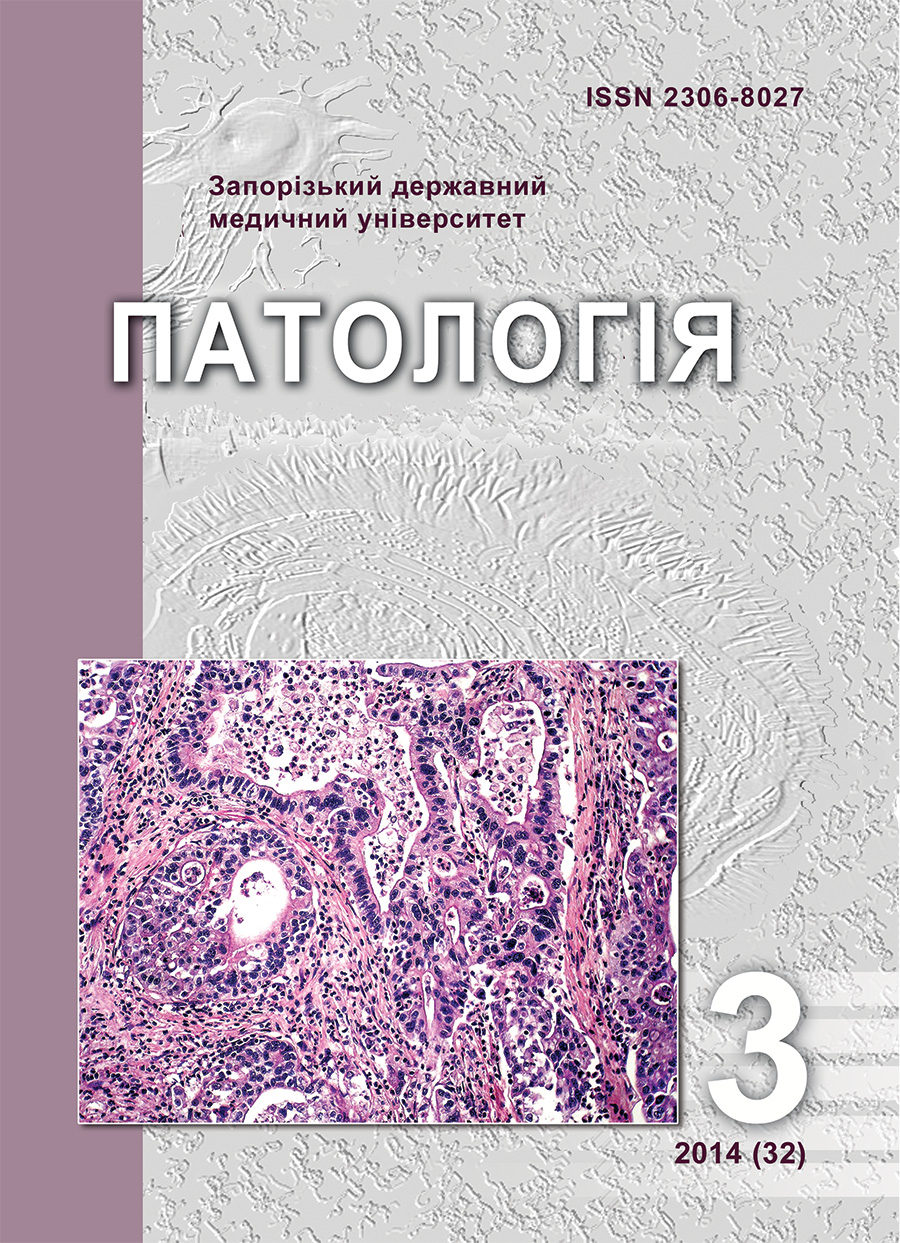Immunohistochemical peculiarities of cell adhesion molecules distribution in benign and malignant brain meningiomas
DOI:
https://doi.org/10.14739/2310-1237.2014.3.37028Keywords:
Meningioma, Cell Adhesion, E-cadherin, β-cateninAbstract
Aim. Meningiomas are widespread neoplasms of the brain, constituting 24-30% of all primary intracranial tumors. In order to determine the expression level of cell adhesion molecules β-catenin and E-cadherin in 20 specimens of brain with the help of immunohistochemical methods the expression of these molecules in benign and malignant meningiomas was investigated.
Methods and results. The correlation relationship between the expression level of β-catenin and E-cadherin in malignant and benign meningiomas was determined. It is shown that the expression level of β-catenin in the different subtypes of benign meningiomas differs and, conversely, they have a similar expression level of E-cadherin.
Conclusion. Most of benign meningiomas are characterized by significantly higher expression levels of cell adhesion molecules than anaplastic ones.
References
Louis, D.N., Ohgaki, H., Wiestler, O.D., &Cavenee, W.K. (Eds.). (2007). World Health Organization Classification of Tumours of the Central Nervous System.IARC, Lyon.
Nagaishi, M., Nobusawa, S., Tanaka, Y., Ikota, H., Yokoo, H., &Nakazato, Y. (2012). Slug, Twist, and E-Cadherin as immunohistochemical biomarkers in meningeal tumors.PLoS One, 7(9), doi: 10.1371/journal.pone.0046053.
Zhou, K., Wang, G., Wang, Y., Jin, H., Yang, S., & Liu, C. (2010).The potential involvement of E-cadherin and beta-catenins in meningioma. PLoS One,5(6), doi: 10.1371/journal.pone.0011231.
Pecina-Slaus, N.,Cicvara-Pecina, T., &Kafka, A. (2012). Epithelial-to-mesenchymal transition: possible role in meningiomas. Frontiers in bioscience (Elite edition), 1(4), 889–896.
Curtis, M.W., Johnson, K.R., &Wheelock, M.J. (2008). E-cadherin/catenin complexes are formed cotranslationally in the endoplasmic reticulum/Golgi compartments. Cell communication & adhesion, 15(4), 365–378.doi: 10.1080/15419060802460748.
van Roy, F., &Berx, G. (2008).The cell-cell adhesion molecule E-cadherin.Cellular and molecular life sciences: CMLS, 65(23), 3756–3788.doi: 10.1007/s00018-008-8281-1.
Stemmler, M. P. (2008). Cadherins in development and cancer.MolecularbioSystems, 4(8), 835–850.doi: 10.1039/b719215k.
Motta, F.J., Valera, E.T., Lucio-Eterovic, A.K., Queiroz, R. G., Neder, L., Scrideli, C. A., et al. (2008). Differential expression of E-cadherin gene in human neuroepithelial tumors.Genetics and molecular research: GMR, 7(2), 295–304.
Ellison, D.W., Onilude, O.E., Lindsey, J.C., Lusher, M. E., Weston, C. L., Taylor, R. E., et al. (2005). Вeta-Catenin status predicts a favorable outcome in childhood medulloblastoma: the United Kingdom Children's Cancer Study Group Brain Tumour Committee. Journal of clinical oncology: official journal of the American Society of Clinical Oncology, 23(31), 7951–7957.
Brunner, E.C., Romeike, B.F., Jung, M., Comtesse, N., & Meese, E. (2006). Altered expression of beta-catenin/E-cadherin in meningiomas.Histopathology, 49(2), 178–187.
Downloads
How to Cite
Issue
Section
License
Authors who publish with this journal agree to the following terms:- Authors retain copyright and grant the journal right of first publication with the work simultaneously licensed under a Creative Commons Attribution License that allows others to share the work with an acknowledgement of the work's authorship and initial publication in this journal.

- Authors are able to enter into separate, additional contractual arrangements for the non-exclusive distribution of the journal's published version of the work (e.g., post it to an institutional repository or publish it in a book), with an acknowledgement of its initial publication in this journal.
- Authors are permitted and encouraged to post their work online (e.g., in institutional repositories or on their website) prior to and during the submission process, as it can lead to productive exchanges, as well as earlier and greater citation of published work (SeeThe Effect of Open Access).

